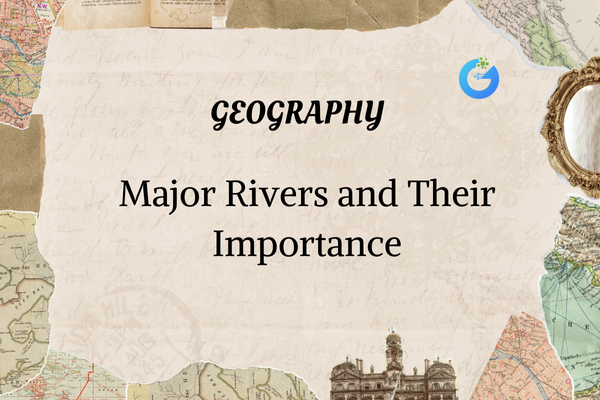Introduction – What Makes Rivers So Important?
Rivers are more than just bodies of water; they are vital lifelines for the world. Rivers provide fresh water for drinking, farming, and industries. They are also crucial for transportation, providing routes for goods and people. But rivers do more than that—through their natural processes, rivers shape landscapes, create fertile land, and support diverse ecosystems. Let’s explore some of the major rivers around the world and learn why they are so important!
expert-led Geography classes – visit our website to learn more
What Are Major Rivers?
Major rivers are long, large rivers that travel across vast distances, often passing through multiple countries. These rivers are usually fed by smaller streams, tributaries, or lakes, and they carry water from inland areas to oceans or seas. Some of the world’s major rivers include:
- The Nile River (Africa)
- Length: Approximately 6,650 kilometers.
- Flow: Northward through northeastern Africa, emptying into the Mediterranean Sea.
- Length: Approximately 6,650 kilometers.
- The Amazon River (South America)
- Length: Approximately 4,345 kilometers.
- Flow: Through the rainforests of Brazil, draining into the Atlantic Ocean.
- Length: Approximately 4,345 kilometers.
- The Yangtze River (China)
- Length: Approximately 6,300 kilometers.
- Flow: Through eastern China into the East China Sea.
- Length: Approximately 6,300 kilometers.
- The Mississippi-Missouri River System (North America)
- Length: Approximately 6,275 kilometers.
- Flow: Through the United States, draining into the Gulf of Mexico.
- Length: Approximately 6,275 kilometers.
- The Ganges River (India)
- Length: Approximately 2,525 kilometers.
- Flow: Through India and Bangladesh, emptying into the Bay of Bengal.
- Length: Approximately 2,525 kilometers.
Why Are Rivers Important?
Rivers are incredibly important to both the environment and human societies. Here are some key reasons why:
- Water Supply: Rivers provide freshwater for drinking, farming, and industries. Many cities and towns are located along rivers to access this essential resource.
- Agriculture: Rivers bring water to surrounding land, making it fertile for farming. River valleys are often the most productive agricultural areas in the world.
- Transportation: Rivers have been used as highways for centuries. They allow goods and people to move easily from one place to another, especially before the invention of modern transportation.
- Energy: Rivers are important sources of hydroelectric power. Water flow is harnessed to generate electricity, providing a renewable energy source.
- Ecosystems: Rivers support a wide range of wildlife, from fish to birds to plants. They create unique ecosystems that are home to many species of animals and plants.
When Do Rivers Become Important?
Rivers have been important since the dawn of civilization. Early human societies relied on rivers for water, transportation, and fertile land for agriculture. Ancient civilizations like Egypt, Mesopotamia, and the Indus Valley thrived along rivers.
- Early Civilizations: The Nile River helped ancient Egypt grow and prosper. The Tigris and Euphrates rivers supported Mesopotamian civilizations, while the Indus River was crucial to the ancient Indus Valley.
- Modern Times: In the modern world, rivers continue to be important for industry, agriculture, and transportation. Many major cities, such as New York City (Hudson River) and London (Thames River), grew along rivers due to their accessibility and resources.
Where Are Major Rivers Located?
Rivers are found on every continent, and each one plays a significant role in its region. Here are some examples of major rivers and their importance:
- The Nile River (Africa)
- Importance: The Nile is the longest river in the world. It provided water to ancient Egypt, helping to create one of the oldest civilizations.
- Fun Fact: The Nile is famous for its annual flooding, which deposited rich silt on the land, making it perfect for farming.
- Importance: The Nile is the longest river in the world. It provided water to ancient Egypt, helping to create one of the oldest civilizations.
- The Amazon River (South America)
- Importance: The Amazon is the largest river by volume of water. It flows through the Amazon Rainforest, the largest rainforest in the world.
- Fun Fact: The Amazon River Basin contains about one-fifth of the world’s fresh water.
- Importance: The Amazon is the largest river by volume of water. It flows through the Amazon Rainforest, the largest rainforest in the world.
- The Yangtze River (China)
- Importance: The Yangtze is the longest river in China and has been a vital source of transportation, water, and irrigation for centuries.
- Fun Fact: The Three Gorges Dam on the Yangtze is the world’s largest hydropower station.
- Importance: The Yangtze is the longest river in China and has been a vital source of transportation, water, and irrigation for centuries.
- The Mississippi-Missouri River System (North America)
- Importance: The Mississippi River is a major transportation route for agricultural products and goods in the U.S. It also plays a role in the ecology of the region.
- Fun Fact: The Mississippi River is home to the largest river delta in the U.S., providing a rich habitat for wildlife.
- Importance: The Mississippi River is a major transportation route for agricultural products and goods in the U.S. It also plays a role in the ecology of the region.
- The Ganges River (India)
- Importance: The Ganges is considered sacred by Hindus and is a crucial water source for millions of people in India and Bangladesh.
- Fun Fact: Millions of people bathe in the Ganges for spiritual purification.
- Importance: The Ganges is considered sacred by Hindus and is a crucial water source for millions of people in India and Bangladesh.
How Do Rivers Form?
Rivers form through the natural process of water collecting and flowing across the land. Here’s how it happens:
- Source: Most rivers begin in mountains or highland areas where rainwater, melted snow, or springs create streams.
- Tributaries: As the river travels downstream, it collects water from smaller streams called tributaries.
- Flow: The river continues to flow downhill, often through valleys and plains, eventually emptying into seas or oceans.
- Delta: Some rivers, like the Nile and Mississippi, form a delta where the river meets the sea. A delta is a landform created by the deposition of sediments carried by the river.
Core Concepts – What You Should Know
| Concept | Meaning | Example |
| River Source | The origin of a river, often found in mountains or springs | The Amazon river starts in the Andes Mountains |
| Tributaries | Smaller streams or rivers that flow into a larger river | The Missouri River is a tributary of the Mississippi River |
| Delta | A landform where a river meets a sea, often rich in nutrients | The Nile Delta in Egypt |
| Floodplain | Flat land next to a river that floods during heavy rain | The Ganges River floodplain in India |
| Hydroelectric Power | Energy produced by using the flow of water from rivers | The Three Gorges Dam on the Yangtze River |
FAQs – Curious Questions Kids Might Ask
Q1: Why do rivers flood?
Rivers flood when they get too much rain or snow melts too quickly. The water overflows from the riverbanks, covering nearby land.
Q2: Can rivers dry up?
Yes, in some places, rivers can dry up, especially if there is little rainfall or if people use a lot of water for farming or other purposes.
Q3: How do rivers change the landscape?
Rivers shape the land by eroding the land around them, carving valleys, and forming features like meanders, deltas, and canyons over time.
Q4: Why are rivers important for farming?
Rivers provide water for irrigation, making dry land fertile for crops. Many civilizations settled near rivers because the soil was rich from river floods.
Q5: How do people use rivers for transportation?
Rivers act like highways, allowing ships and boats to move goods and people. Many large cities, like New York, are located along rivers for easy access to transportation.
Fun Facts About Rivers
- The Amazon River is so large that it carries about one-fifth of the world’s fresh water!
- The Mississippi River was once used by early settlers to move goods from the American Midwest to the Gulf of Mexico.
- The Yangtze River is home to the Yangtze Giant Softshell Turtle, one of the world’s rarest species!
- The Ganges River is used for both bathing and religious rituals, making it a major cultural symbol in India.
- The Nile River helped Egypt become one of the first great civilizations due to its fertile soil and reliable water source.
Conclusion – Rivers Shape Our World
Rivers are essential to life on Earth, providing water, fertile land, transportation, and power. From the Amazon to the Nile, each major river has shaped the culture, economy, and environment of the regions it flows through. Understanding the importance of rivers helps us appreciate their role in sustaining life and maintaining the balance of our planet’s ecosystems.








